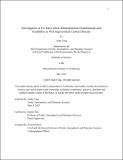| dc.contributor.advisor | Ono, Shuhei | |
| dc.contributor.author | Fong, Andy | |
| dc.date.accessioned | 2025-07-07T17:38:57Z | |
| dc.date.available | 2025-07-07T17:38:57Z | |
| dc.date.issued | 2025-05 | |
| dc.date.submitted | 2025-05-23T17:05:46.780Z | |
| dc.identifier.uri | https://hdl.handle.net/1721.1/159925 | |
| dc.description.abstract | With the world on average a degree Celsius warmer than the preindustrial 1850s, mitigating global warming is an urgent yet technically complex goal. Carbon mineralization, the trapping of carbon dioxide in the mineral phase via reaction with magnesium/calcium-rich silicates to form carbonates, is a promising method to offset carbon emissions. In addition to the reaction with carbon dioxide dissolved in water, these silicates have also been shown to be reactive with water-saturated (wet) supercritical carbon dioxide, but the rates are poorly constrained. In this study, we investigate the kinetics of carbonating olivine, a magnesium silicate-rich mineral, in wet supercritical carbon dioxide at 90 bars between 50 to 170 °C over time. We find that we can sufficiently model the complex dependence of olivine carbonation rates with a nucleation-crystallization mechanism for any temperature and grain size at 90 bars, although more data is necessary to confirm the model’s accuracy. Using our developed model, we predict that we can achieve near-complete carbonation at 300 °C using <10 micron olivine grains in a single day. Scaling of the process suggests that between 0.8 and 1.3 MWh is required per ton of carbon dioxide captured (via amine scrubbing) and sequestered as carbonates, depending on the energy source, which is comparable to recent carbon mineralization strategies such as those proposed by Carbfix. Furthermore, the silica and carbonate product can be utilized for various industrial applications totaling to an estimated $461 million for 0.7 megatons of carbon dioxide mineralized, which is Carbfix’s 2028 carbon capture goal. Alternatively, aquatic storage of sequestered carbon dioxide can enhance carbon sequestration by up to twofold, leading to between 0.4 and 1.3 MWh per ton of carbon dioxide captured and stored, although such an initiative would be economically inviable. We anticipate that large-scale carbon mineralization initiatives in the future need to be both effective and profitable for continued operation. Therefore, this initial evaluation of carbon mineralization in wet supercritical carbon dioxide reveals its environmental and economic viability at large scale. Application of wet scCO₂ carbonation to other minerals such as serpentine or basalt will ultimately require testing their competency to be carbonated in such conditions. | |
| dc.publisher | Massachusetts Institute of Technology | |
| dc.rights | In Copyright - Educational Use Permitted | |
| dc.rights | Copyright retained by author(s) | |
| dc.rights.uri | https://rightsstatements.org/page/InC-EDU/1.0/ | |
| dc.title | Investigation of Ex-Situ Carbon Mineralization Fundamentals andScalability in Wet Supercritical Carbon Dioxide | |
| dc.type | Thesis | |
| dc.description.degree | S.B. | |
| dc.contributor.department | Massachusetts Institute of Technology. Department of Earth, Atmospheric, and Planetary Sciences | |
| mit.thesis.degree | Bachelor | |
| thesis.degree.name | Bachelor of Science in Earth, Atmospheric, and Planetary Sciences | |
